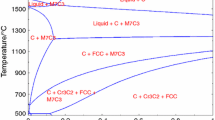Abstract
A thermodynamic analysis is carried out for reducing chromium from chromium contacting carbon in gas phase Н2–Н2О–СО–СО2. Considering the normalization condition \({{x}_{{{{{\text{H}}}_{{\text{2}}}}{\text{O}}}}} + {{x}_{{{{{\text{H}}}_{{\text{2}}}}}}} + {{x}_{{{\text{C}}{{{\text{O}}}_{{\text{2}}}}}}} + {{x}_{{{\text{CO}}}}} = 1\), the oxidizing potential \(\left( {{{p}_{{{{{\text{O}}}_{{\text{2}}}}}}}} \right)\) of the gas phase is determined using two nomograms in coordinates \(\log \left( {\frac{{{{x}_{{{\text{C}}{{{\text{O}}}_{{\text{2}}}}}}}}}{{{{x}_{{{\text{CO}}}}}}}} \right)\)–T and \(\log \left( {\frac{{{{x}_{{{{{\text{H}}}_{2}}{\text{O}}}}}}}{{{{x}_{{{{{\text{H}}}_{2}}}}}}}} \right)\)–T. The potential parameters of chromium reduction from Cr2O3 are determined through calculating the ratio of oxide dissociation pressure to the gas phase oxidation potential. In the CO–CO2–C system, chromium is reduced at a temperature of 1505 K if xCO > 0.9995. At this temperature, compound Cr2O3 is reduced in water-gas having composition \({{x}_{{{{{\text{H}}}_{{\text{2}}}}}}}\) = 0.0186, \({{x}_{{{{{\text{H}}}_{{\text{2}}}}{\text{O}}}}}\) = 0.28 × 10–4, xCO = 0.9809, \({{x}_{{{\text{C}}{{{\text{O}}}_{{\text{2}}}}}}}\) = 4.86 × 10–4; this compound features the oxidation potential equal to the oxide dissociation pressure: \(\log {{\left( {{{p}_{{{{{\text{O}}}_{{\text{2}}}}}}}} \right)}_{{{\text{C}}{{{\text{r}}}_{{\text{2}}}}{{{\text{O}}}_{{\text{3}}}}}}}\) = –17.082. When the hydrogen concentration increases from 0.0186 to 0.9900, the oxidizing potential of water-gas contacting carbon drops by four orders of magnitude: down to \({{\left( {\log {{p}_{{{{{\text{O}}}_{{\text{2}}}}}}}} \right)}_{{{\text{gas}}}}}\) = –21.09. This should result in a significant increase in the recovery rate. Chromium can be reduced in this gaseous atmosphere at a temperature of 1230 K. There is a simple and cheap process to obtain reducing water-gas, for example, by heating water vapor contacting carbon. It is shown that at a temperature of 1500 K, Н2О and СО2 traces can be found in water-gas having parameters \({{x}_{{{{{\text{H}}}_{{\text{2}}}}}}}\) = 0.4999, xCO = 0.4996, \(\log \left( {\frac{{{{x}_{{{{{\text{H}}}_{2}}{\text{O}}}}}}}{{{{x}_{{{{{\text{H}}}_{2}}}}}}}} \right)\) = –3.12, \(\log \left( {\frac{{{{x}_{{{\text{C}}{{{\text{O}}}_{{\text{2}}}}}}}}}{{{{x}_{{{\text{CO}}}}}}}} \right)\) = –3.59. The oxidizing potential in this gas is lower than that of chromium oxide with this difference increasing significantly when the temperature grows.





Similar content being viewed by others
REFERENCES
Waldenstram, M. and Uhrenius, B., A thermodynamic analysis of the Fe–Cr–C, Scand. J. Metall., 1977, vol. 6, no. 5, pp. 202–210.
Kaufman, L. and Nesor, H., Coupled phase diagrams and thermochemical data for transition metal binary system IV, CALPHAD: Comput. Coupling Phase Diagrams Thermochem., 1988, vol. 12, no. 3, pp. 225–246.
Herzman, S. and Sandman, B., A thermodynamic analysis of the Fe–Cr, CALPHAD: Comput. Coupling Phase Diagrams Thermochem., 1982, vol. 6, no. 1, pp. 67–80.
Andersson, J.-O., A thermodynamic evaluation of the Fe–Cr–C system, Metall. Trans. A, 1988, vol. 19, nos. 1–6, pp. 627–636.
Materialy IV-ya mezhdunarodnoi nauchno-prakticheskoi konferentsii “Perspektivy razvitiya metallurgii i mashinostroeniya s ispol’zovaniem zavershennykh fundamental’nykh issledovanii i NIOKR” (Proc. IV Int. Sci.-Pract. Conf. “Prospective Development of Metallurgy and Machine Engineering Using Completed Fundamental Research and R&D”), Yekaterinburg: Al’fa Print, 2018.
Bondarenko, B.I., Vosstanovlenie oksidov metallov v slozhnykh gazovykh sistemakh (Reduction of Metal Oxides in Complex Gas Systems), Kiev: Naukova Dumka, 1980.
Chernobrovin, V.P., Pashkeev, I.Yu., Mikhailov, G.G., et al., Teoreticheskie osnovy protsessov proizvodstva uglerodistogo ferrokhroma iz ural’skikh rud (Theoretical Foundations of Carbon Ferrochrome Production from the Ural Ores), Chelyabinsk: Yuzh.-Ural. Gos. Univ., 2004.
Mikhailov, G.G., Leonovich, B.I., and Kuznetsov, Yu.S., Termodinamika metallurgicheskikh protsessov i sistem (Thermodynamics of Metallurgical Processes and Systems), Moscow: Mosk. Inst. Stali Splavov, 2009.
Kazachkov, E.A., Raschety po teorii metallurgicheskikh protsessov (Calculations based on Theory of Metallurgical Processes), Moscow: Metallurgiya, 1988.
Kulikov, I.S., Termodinamika oksidov (Thermodynamics of Oxides), Moscow: Metallurgiya, 1986.
Holzheid, A. and O’Neill, H., The Cr–Cr2O3 oxygen buffer and the free energy of formation of Cr2O3 from high-temperature electrochemical measurement, Geochim. Cosmochim. Acta, 1995, vol. 59, no. 3, pp. 475–479.
Toker, N.Y., Darken, L.S., and Muan, A. Equilibrium phase relation and thermodynamics of the Cr–O system in the temperature range of 1500 to 1825°C, Metall. Trans. B, 1991, vol. 22, no. 2, pp. 225–232.
Kubaschewski, O. and Alcock, C.B., Metallurgical Thermochemistry, Oxford: Pergamon, 1967.
Japan Society for the Promotion of Science, Steelmaking Data Sourcebook: 19th, Boca Raton, FL: CRC Press, 1988.
Muan A. and Osborn E.F., Phase Equilibria among Oxides in Steelmaking, New York: Pergamon, 1965.
Vyatkin, G.P., Kuznetsov, Yu.S., Mikhailov, G.G., and Kachurina, O.I., Termodinamika vosstanovleniya zheleza iz oksidov (Thermodynamics of Iron Reduction from Oxides), Chelyabinsk: Yuzh.-Ural. Gos. Univ., 2017.
Pripisnov, O.N., Synthesis of composite materials based on chromium carbides using preliminary mechanical activation, Extended Abstract of Cand. Sci. (Eng.) Dissertation, Moscow: Moscow Inst. Steel Alloys, 2015.
Nozdrin, I.V., Development of scientific foundations and technology for plasma metallurgical production of boride and chromium carbide nanopowders, Extended Abstract of Doctoral (Eng.) Dissertation, Novokuznetsk: Sib. State Ind. Univ., 2015.
Berkane, R., Gachon, J.C., Charles, J., and Hortz, J., A thermodynamic study of the chromium-carbon system, CALPHAD: Comput. Coupling Phase Diagrams Thermochem., 1987, vol. 11, no. 2, pp. 152–159.
Maluchi, H., Sano, N., and Matsushita, Y., The standard free energy of formation of Cr3C2 by the electromotive force method, Metall. Trans., 1971, vol. 2, no. 6, pp. 1503–1506.
Shatynski, S.R., Thermochemistry of transition metal carbides, Oxid. Met., 1979, vol. 3, no. 2, pp. 105–118.
Celtters, R.G. and Belton, G.R., High temperature thermodynamic properties of the chromium carbides Cr7C3 and Cr3C2 determined using a galvanic cell technique, Metall. Trans. B, 1985, vol. 15, no. 4, pp. 517–521.
Strokina, I.V. and Yakushevich, N.F., Changes of redox properties of gaseous phase of C–O2–H2 system, Izv. Vyssh. Uchebn. Zaved., Chern. Metall., 2011, vol. 54, no. 6, pp. 3–5.
Kuznetsov, Yu.S. and Kachurina, O.I., Redox properties of gas phases, Steel Transl., 2018, vol. 48, no. 1, pp. 25–33.
Grishin, A.M., Simonov, V.K., and Shcheglova, I.S., Disparity of kinetic laws to thermodynamics preconditions of reactions of carbon gasification by H2O and CO2, Izv. Vyssh. Uchebn. Zaved., Chern. Metall., 2013, vol. 56, no. 7, pp. 64–67.
Author information
Authors and Affiliations
Corresponding authors
Additional information
Translated by V. Vetrov
About this article
Cite this article
Kuznetsov, Y.S., Kachurina, O.I. Thermodynamic Analysis of Recovering Chrome from Cr2O3 . Steel Transl. 50, 855–864 (2020). https://doi.org/10.3103/S0967091220120074
Received:
Revised:
Accepted:
Published:
Issue Date:
DOI: https://doi.org/10.3103/S0967091220120074



